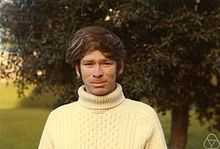Richard Laver
From Wikipedia, the free encyclopedia

Richard Laver
Richard Laver (1942–2012) was an American mathematician, working in set theory. He received his PhD at the University of California, Berkeley in 1969, under the supervision of Ralph McKenzie, with a thesis on Order Types and Well-Quasi-Orderings. The largest part of his career he spent as Professor and later Emeritus Professor at the University of Colorado at Boulder.
Richard Laver died in Boulder, CO, on September 19, 2012 after a long illness.[1]
His main results
Among Laver's notable achievements some are the following.
- Using the theory of better-quasi-orders, introduced by Nash-Williams, (an extension of the notion of well-quasi-ordering), he proved[2] Fraïssé's conjecture: if (A0,≤),(A1,≤),...,(Ai,≤),,, are countable ordered sets, then for some i<j (Ai,≤) isomorphically embeds into (Aj,≤). This also holds if the ordered sets are countable unions of scattered ordered sets.[3]
- He proved[4] the consistency of the Borel conjecture, i.e., the statement that every strong measure zero set is countable. This important independence result was the first when a forcing (see Laver forcing), adding a real, was iterated with countable support iteration. This method was later used by Shelah to introduce proper and semiproper forcing.
- He proved[5] the existence of a Laver function for supercompact cardinals. With the help of this, he proved the following result. If κ is supercompact, there is a κ-c.c. forcing notion (P, ≤) such that after forcing with (P, ≤) the following holds: κ is supercompact and remains supercompact in any forcing extension via a κ-directed closed forcing. This statement is used, for example in the proof of the consistency of the proper forcing axiom and variants.
- Laver and Shelah proved[6] that it is consistent that the continuum hypothesis holds and there are no ℵ2-Suslin trees.
- Laver proved[7] that the perfect subtree version of the Halpern–Läuchli theorem holds for the product of infinitely many trees. This solved a longstanding open question.
- Laver started[8][9][10] investigating the algebra that j generates where j:Vλ→Vλ is some elementary embedding. This algebra is the free left-distributive algebra on one generator. For this he introduced Laver tables.
- He also showed[11] that if V[G] is a (set-)forcing extension of V, then V is a class in V[G].
References
- ↑ Obituary, European Set Theory Society
- ↑ R. Laver: On Fraïssé's order type conjecture, Ann. of Math. (2), 93(1971), 89–111.
- ↑ R. Laver: An order type decomposition theorem, Ann. of Math., 98(1973), 96–119.
- ↑ R. Laver: On the consistency of Borel's conjecture, Acta Math., 137(1976), 151–169.
- ↑ R. Laver: Making the supercompactness of κ indestructible under κ-directed closed forcing, Israel J. Math., 29(1978), 385–388.
- ↑ R. Laver, S. Shelah: The ℵ2 Souslin hypothesis, Trans. Amer. Math. Soc., 264(1981), 411–417.
- ↑ R. Laver: Products of infinitely many perfect trees, Journal of the London Math. Soc., 29(1984), 385–396.
- ↑ R. Laver: The left-distributive law and the freeness of an algebra of elementary embeddings, Advances in Mathematics, 91(1992), 209–231.
- ↑ R. Laver: The algebra of elementary embeddings of a rank into itself, Advances in Mathematics, 110(1995), 334–346.
- ↑ R. Laver: Braid group actions on left distributive structures, and well orderings in the braid groups, Jour. Pure and Applied Algebra, 108(1996), 81–98.
- ↑ R. Laver: Certain very large cardinals are not created in small forcing extensions, Annals of Pure and Applied Logic, 149(2007) 1–6.
External links
This article is issued from Wikipedia. The text is available under the Creative Commons Attribution/Share Alike; additional terms may apply for the media files.